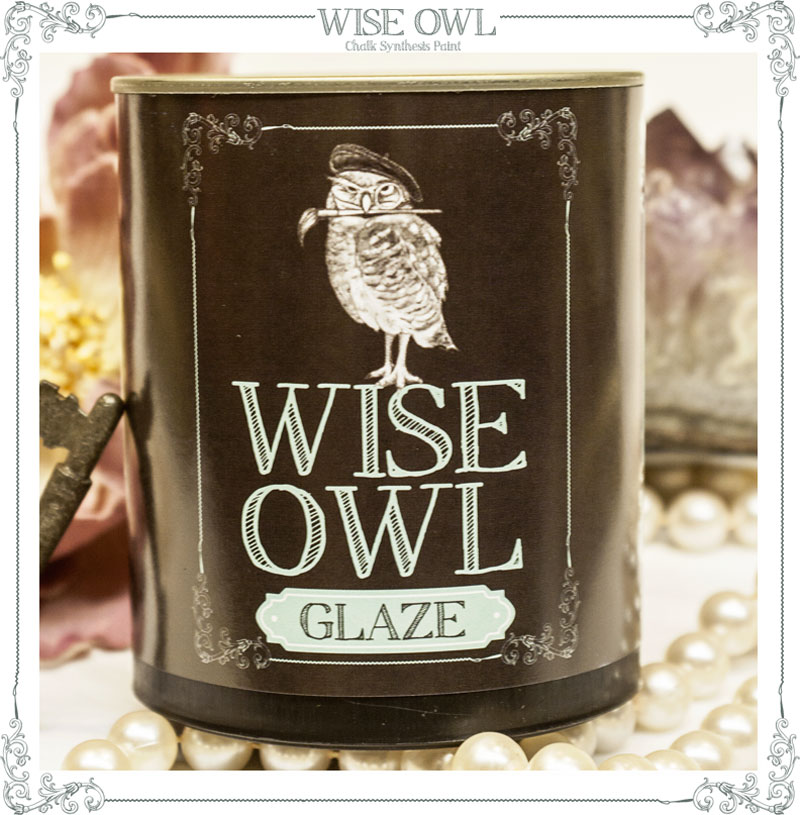Wise Owl Glaze -are you doing it wrong?

Wise Owl Glaze is one of the most amazing and dimension creating finishes. So many folks are confused about the process so I decided to share application and technique details. You may be doing it wrong, but you may be doing it right! Read on to find out.
What is glaze? Wise Owl Glaze is a water based finishing and dimension creating product that contains either flat or metallic pigments depending on selection. It can create unique character as well as act as a sealing product simultaneously. It may be used over painted pieces or alone over wood for a gel stain finish. Glaze is a thinner consistency than paint and is designed to be applied and immediately wiped away to create a desired finish.

Some Common Mistakes;
- Expecting perfect uniformity
Glazing your piece will not result in absolute uniformity, nor should it. The beauty of glaze is in the imperfections. Glazes should be used to create a faceted finish with dimension. The end result should accentuate detailed areas and curves of your piece. It should be allowed to collect in the details, create a patina, or mimic a time worn effect. Not all glazes are used to antique pieces, Opalescent Pearl Glaze, for instance, adds a subtle luminescent pearl effect. Black Walnut Glaze is used to create a vintage patina and to tone down brighter colors by adding a deep antique brown wash to your finish. Since it is designed to be applied and wiped away, seeking a perfectly uniform finish would be near impossible. Glaze can mimic what years and years of time can do to a piece. Imagine age and rustic staining collecting in different areas depending on wear and finish. To recreate this is a balance, you must dance between too far distressed and not going far enough. You should think about what time would do to a piece. Focus on letting glaze settle where it may and experiment with different techniques of application and different tools to wipe it away to create different effects.


- Glazing over a surface that is less than buttery smooth
Chalk based minerals paints are porous. It is he negative pore space (tiny air molecules in the paint matrix) created by the minerals that allows the supreme adhesion of the paint. These little microscopic holes in the paint create tiny hills and valleys in your surface and can produce a muddy appearance when glazed if a little prep isn’t employed. A smooth surface will allow the most control while glazing. Furthermore, you have less of a chance of allowing lint from your cloth from entering your finish from the texture of the surface you are glazing. An unsanded surface will soak up more glaze and can quickly muddy up your entire finish, sometimes creating a more dramatic effect than was intended. Some detailed surfaces cannot be sanded, so glaze will be absorbed more in these areas and will add to the vintage effect. To prep for glaze, lightly sand your painted surface with 350 grit or above sand paper or a sanding block. At this time distress if desired, focusing on the details and edges of your piece. Once again, you are attempting to recreate a time worn effect. Over the years, the edges and detailed areas of painted pieces are expected to get the most wear and tear, so focus your efforts there for a more authentic finish. After sanding, wipe away dust created from sanding with a lint free cloth.


- Using the wrong tool to apply and remove glaze
Lint does not belong in your finish. If you use a new fuzzy washcloth for application or removal, some of the lint can be transferred to your finish. Glaze can be applied using a paint brush, sponge, or cloth. One of my favorite tools to apply and wipe away glaze is a business sock. This provides ease of application since they usually don’t have much in terms of lint compared to let’s say, a gym sock. You can also have more control of your finish by putting socks on both hands. Yes, like a sock puppet, time to play glaze hands! Use one hand for application working in small but long sections. Dip sock hand A in a little glaze and then wipe away immediately with sock hand B. Continue working while avoiding overlapping the finish since glaze can remove glaze so overlapping areas can result in a lighter glazed finish and produce a striped effect.

- Over working your glaze
Glaze has a relatively quick dry time and you need to work efficiently. Continuing to wipe away glaze over and over as it begins to dry may muddy up the finish quickly. Make a few passes until desired amount of glaze is removed from finish, and move on. Applying too little glaze will shorten your working time, so make sure to apply an adequate amount to length work-ability. If you don’t like how the glaze is laying down in a particular area you may apply additional glaze to remove some of the glaze finish and begin anew. This technique has a short window and can only be employed before glaze is fully dry. If you want a more dramatic glaze effect than your completed finish, glaze may be applied a second time as long as the first coat has fully dried. Glaze colors may also be layered for added dimension.

- Using too much elbow grease to apply or remove glaze
Glaze needs to be applied and removed with a soft hand, pushing too hard is simply recreating the wet distressing technique (using a wet cloth to remove paint instead of distressing with sandpaper.) This technique is great if you would like to use the glaze to remove paint in some areas, but if you are unintentionally pulling up paint, you need to employ a lighter touch.
- Starting your glaze application of the most visible part of your piece
If you are glazing a table, you do not want to start right on the top where your glazed finish will be most visible. You will warm up as you go, and although I have glazed many pieces, I still prefer to start by focusing on the legs and bottom of my piece first.


Consider practicing on a smaller piece until you decide on the right application method and tools and techniques to create your desired finish. You may find your own techniques that work best for you. Finally, glaze produces a strong finish, but a polyurethane (oil based poly), polycrilic (water based poly) may also be used if desired for added protection on high traffic pieces. Be mindful that if you wax or hemp oil over glaze, it will need to be buffed thoroughly, since there will not be much in terms of pore space for the wax to be absorbed into the surface. Glaze is my favorite of all finishes and reaps the most curb appeal in my book. If dimension and character is your goal, try it and see for yourself. Check out our Color Selection Guide post for some recommended glaze pairings. As always, happy painting!

